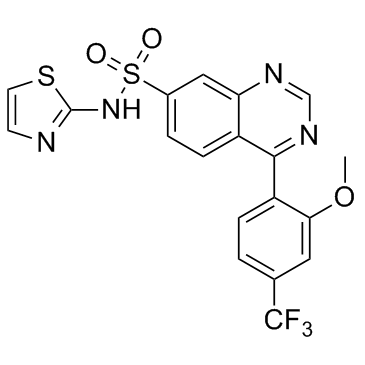AM-2099 |
| Catalog No.GC30917 |
L'AM-2099 est un inhibiteur puissant et sélectif du canal sodique voltage-dépendant Nav1.7 avec une IC50 de 0,16 μM pour Nav1.7 humain.
Products are for research use only. Not for human use. We do not sell to patients.

Cas No.: 1443373-17-8
Sample solution is provided at 25 µL, 10mM.
AM-2099 is a potent and selective inhibitor of voltage-gated sodium channel Nav1.7 with an IC50 of 0.16 μM for human Nav1.7.
In heterologous cells, comparable inhibition is observed across human, mouse, dog, and cynomolgus monkey NaV1.7 with reduced activity against rat NaV1.7. AM-2099 is more than 100-fold selective over Nav1.3, Nav1.4, Nav1.5, and Nav1.8, while lower levels of selectivity are observed against Nav1.1, Nav1.2, and Nav1.6. AM-2099 demonstrates low affinity for hERG (>30 µM) and does not show greater than 50% inhibition against a panel of 100 kinases (1 µM) and a broad CEREP panel (10 µM). [1].
AM-2099 demonstrates a favorable pharmacokinetic profile in rat and dog. In rats AM-2099 shows low total clearance and moderate Vdss and half-life. In contrast, when dosed in dogs AM-2099 shows very low clearance, a low Vdss and long halflife (18 h). AM-2099 demonstrates a dose-dependent increase in plasma exposure with a concomitant dose-dependent reduction in scratching bouts compared to vehicle-treated animals, with a statistically significant reduction observed at the 60 mg/kg dose[1].
[1]. Marx IE, et al. Sulfonamides as Selective NaV1.7 Inhibitors: Optimizing Potency and Pharmacokinetics to Enable in Vivo Target Engagement. ACS Med Chem Lett. 2016 Sep 21;7(12):1062-1067.
Animal experiment: | Mice: AM-2099 (5, 20, 60 mg/kg) is dosed orally to C57BL/6 male mice 120 minutes prior to intradermal administration of histamine. Instances of scratching behavior are then measured over a 30-minute time period[1]. |
References: [1]. Marx IE, et al. Sulfonamides as Selective NaV1.7 Inhibitors: Optimizing Potency and Pharmacokinetics to Enable in Vivo Target Engagement. ACS Med Chem Lett. 2016 Sep 21;7(12):1062-1067. | |
| Cas No. | 1443373-17-8 | SDF | |
| Canonical SMILES | COC1=CC(C(F)(F)F)=CC=C1C2=NC=NC3=CC(S(=O)(NC4=NC=CS4)=O)=CC=C32 | ||
| Formula | C19H13F3N4O3S2 | M.Wt | 466.46 |
| Solubility | DMSO : ≥ 150 mg/mL (321.57 mM) | Storage | Store at -20°C |
| General tips | Please select the appropriate solvent to prepare the stock solution according to the
solubility of the product in different solvents; once the solution is prepared, please store it in
separate packages to avoid product failure caused by repeated freezing and thawing.Storage method
and period of the stock solution: When stored at -80°C, please use it within 6 months; when stored
at -20°C, please use it within 1 month. To increase solubility, heat the tube to 37°C and then oscillate in an ultrasonic bath for some time. |
||
| Shipping Condition | Evaluation sample solution: shipped with blue ice. All other sizes available: with RT, or with Blue Ice upon request. | ||
| Prepare stock solution | |||

|
1 mg | 5 mg | 10 mg |
| 1 mM | 2.1438 mL | 10.719 mL | 21.4381 mL |
| 5 mM | 0.4288 mL | 2.1438 mL | 4.2876 mL |
| 10 mM | 0.2144 mL | 1.0719 mL | 2.1438 mL |
Step 1: Enter information below (Recommended: An additional animal making an allowance for loss during the experiment)
 g
g
 μL
μL

Step 2: Enter the in vivo formulation (This is only the calculator, not formulation. Please contact us first if there is no in vivo formulation at the solubility Section.)
Calculation results:
Working concentration: mg/ml;
Method for preparing DMSO master liquid: mg drug pre-dissolved in μL DMSO ( Master liquid concentration mg/mL, Please contact us first if the concentration exceeds the DMSO solubility of the batch of drug. )
Method for preparing in vivo formulation: Take μL DMSO master liquid, next addμL PEG300, mix and clarify, next addμL Tween 80, mix and clarify, next add μL ddH2O, mix and clarify.
Method for preparing in vivo formulation: Take μL DMSO master liquid, next add μL Corn oil, mix and clarify.
Note: 1. Please make sure the liquid is clear before adding the next solvent.
2. Be sure to add the solvent(s) in order. You must ensure that the solution obtained, in the previous addition, is a clear solution before proceeding to add the next solvent. Physical methods such as vortex, ultrasound or hot water bath can be used to aid dissolving.
3. All of the above co-solvents are available for purchase on the GlpBio website.
Quality Control & SDS
- View current batch:
- Purity: >98.00%
- COA (Certificate Of Analysis)
- SDS (Safety Data Sheet)
- Datasheet
Average Rating: 5 (Based on Reviews and 11 reference(s) in Google Scholar.)
GLPBIO products are for RESEARCH USE ONLY. Please make sure your review or question is research based.
Required fields are marked with *



















